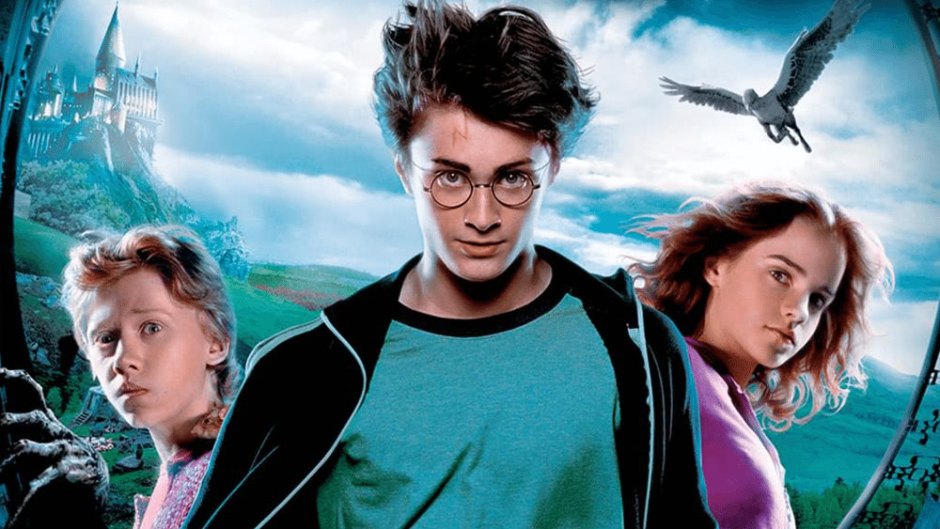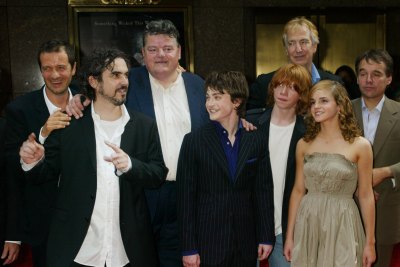
Warner Bros
The Making Of ‘Harry Potter And The Prisoner Of Azkaban’ — An Oral History (EXCLUSIVE)
Harry Potter and The Prisoner of Azkaban, the third chapter in the Harry Potter film series following The Sorcerer’s Stone and The Chamber of Secrets, represented a time of change for the students of Hogwarts. They were getting older and, despite the magical setting they found themselves in, were dealing with real-world issues. Among them: Voldemort getting stronger and Harry discovering that his godfather, Sirius Black, who had been framed and imprisoned for a crime he did not commit, had broken free of Azkaban prison.
All told, it was a changing world, and change was taking place behind the scenes as well. For starters, Chris Columbus, who had brought the first two films to life, was departing, serving as a producer of Prisoner of Azkaban before leaving the franchise for good, and leaving Alfonso Cuaron in charge of directing. Scroll down to read an oral history on the making of The Prisoner of Azkaban!
CHRIS COLUMBUS (Producer): “I chose not to direct in order to spend time with my kids while they are young. I felt it was an important time for me to be there, but I wanted to stick around for three films to make sure that there is a good transition for the actors in the film and that the quality of the films remained the same. I also wanted to make sure the ‘comfort level’ was still there for the viewers in the sense of the world and the characters.”
DAVID HEYMAN (Producer): “A lot of the foundations had been built by Chris and Alfonso embraced that, yet I think we as a franchise have to continue to allow directors to make their own films. It’s really important that each director is able to put his or her own stamp on a film. Chris made his stamp, Alfonso made his. But the foundations are there and as long as you are true to those foundations and to the spirit of the books, I think we’re in good shape. Alfonso has a keen understanding of the nuances of teenage life. His film, Y Tu Mama, is about the last moments of adolescence, and Azkaban is about the first. The third film grows out of what has already been created. The third book is slightly more mature. The film is a little darker, more mature, and more adult, just as the book is. Also, Alfonso is a different filmmaker from Chris, and I think the film necessarily reflects that, because film is a director’s medium.”

ALFONSO CUARON (Director): “My primary goal was to lead the characters, and the actors playing them into adolescence by tapping in to some very real emotions and having them deal with life-and-death situations. To help accomplish this, I asked each of the leads to write a first-person bio of their character, but immersing those characters in their own experiences and emotions.
“They delivered these amazing essays, really beautiful, very honest, very bare, and very courageous. That became an amazing tool and an amazing key to work with them. I also think it allowed them to have a better emotional understanding of the characters. Sometimes it was a shortcut to be able to say, ‘This is more the Hermione side of your mind.’ Emma would get it immediately without having to go into big conversations or examples, because it’s honestly coming from something that she wrote, that she experienced. When it comes to their emotions, this is not something that I am trying to do, but I think it’s implicit in the material. These kids were a little older and in that moment of life where that little older means a lot older, while they were still carrying a lot of vulnerabilities of earlier years. The age of 13 is archetypal in every civilization on this planet. It is the rite of passage; the moment of awareness. Thirteen is the age of Bar Mitzvahs, first Communions, and so on. Because of that, it is not that the film is darker, it’s just more internal.”
The Cast on Their New Director
From what they’ve said, it’s obvious that Daniel Radcliffe, Emma Watson and Rupert Grint were all — despite their love for Chris Columbus — excited about the new possibilities that accompanied Alfonso.

DANIEL RADCLIFFE (Actor, “Harry Potter”): “I think everything that we learned from Chris, we were now able to put into practice with a different director. I think the reason Alfonso was able to do longer takes and was able to do more complicated shots was because with Chris we just didn’t have the experience or the focus to do that kind of stuff. And so, with Alfonso, we were just getting the shot. And it is harder, it’s more challenging — which is good, because if we’re getting older and we’re not being challenged, then there’s no point in doing it, really. But I think it’s just that we learn more with each director.”
RUPERT GRINT (Actor, “Ron Weasley”): “Chris always had this fantastically energetic approach to doing the scenes, which suited the first two films absolutely perfectly. He made two absolutely fantastic films. With the third one, Alfonso has a much more kind of laid-back, emotional, intense way of directing.”
EMMA WATSON (Actress, “Hermione Granger”): “As someone who hadn’t acted in anything else before, it was great working with a new director and doing something different, seeing different techniques, different ideas. I think there’s definitely a difference in style just looking at the two [directors]. Alfonso’s done some amazing things with camera angles and camera shots, and this one is much more flowy — you can just tell the difference. Especially with the director, a lot of himself goes into what he’s doing and you can definitely tell the difference.”

MAGGIE SMITH (Actress, “Professor McGonnagall”): “Alfonso was just enchanting. He’s great and the children got on very well with him. He has a very thick accent, but they were all very, very fond of him and he’s like a kid himself. He was a great joy on the set and Chris Columbus was still there to keep a continuity with the children, because they would have been lost without him.”
CHRIS RANKIN (Actor, “Percy Weasley”): “His style is completely different to Chris Columbus’, he went for a real dramatic tension building to a climax kind of film, which I think was perfect for Potter 3. I think the way Alfonso did it, the way he shot it, the style of camera work he used — just everything is reflected a slow and dramatic build to an amazing end.”
ROBBIE COLTRANE (Actor, “Hagrid”): “Chris was always very hands-on. One of the many things I liked about Chris is that he wasn’t one of those directors who sits by those monitors and goes, ‘Again, no, again.’ Between takes, he runs to the set and tells everybody what was wrong, so everyone knows what was wrong so then you have a chance at doing it right next time. You would have thought that was an obvious thing, but it’s something a lot of directors miss. So he’s very hands-on and very good with the kids, too, because they were kind of at that odd age. And so he he knew exactly how protected they needed to be, but he also knew that they’re up for a little bit of semi-adult situations.
“Alfonso has got a different style of shooting. I mean, you’ll have to ask him, but I know he was very keen to get it out of the studio, because it was very studio-bound. That’s the trouble with anything which essentially has lots of bits which are physically impossible. You’re stuck in a studio. And that has to change. You’re making a movie, you want to make a good one. And I think he was very keen to do that.”

DANIEL RADCLIFFE: “The difference between Alfonso and Chris Columbus is that Chris’ got an energetic way of working which suits the first films. Alfonso’s got a mild intensity that works better with this material.”
GARY OLDMAN (Actor, “Sirius Black”): “That’s one of the reasons I accepted his offer, apart from needing the money. I like his style, he does his own stuff and it shows that the producers have courage. He’s remarkably good.”
Alfonso’s dedication to character became apparent through every aspect of production, including the film’s visual effects — an area that was, admittedly, new to him.
ALFONSO CUARON: “My approach to the visual effects is that I wanted to do a character-driven piece with cool visual effects, rather than a visual effects movie with some characters running around. I think the first thing we should do is subordinate the visual effects totally to the story and to the universe, and part of the rule was to make it look as real as possible and as organic as everything else. Originally, I was suspicious about CG, so I went to use more old-fashioned things like split screens and puppets. The Dementors were designed first, so we made puppets of them, and we used a puppeteer named Basil Twist, who is based in San Francisco. He does puppets underwater, so he has these beautiful fabrics for underwater. He came to supervise some tests for how the Dementors should work or move, but we knew we had to go CG. The wise men at ILM took our Dementor underwater test for motion reference, and those tests showed the fabrics floating and moving very eerily, and that was incorporated into the movement of the Dementors.”

He emphasizes that in terms of directorial style, especially when compared to those who came before and would come after, he wasn’t trying to do anything unique.
ALFONSO CUARON: “The funny thing is, I was trying to serve the story, but at the same time I’m a different mind than Michael Newell, who directed Goblet of Fire, or Chris. I operate in different ways and respond to different things and I have different flows and different urges than the two of them. I made some decisions in this film which were not just to stand out, but because I felt they were the right things in my understanding of how to serve the story. I think you have to see the film to decide what I contributed to it. But this whole thing has been an interesting lesson for one’s ego, where you just surrender yourself to the material. And you find out that by restraining yourself, you’re doing some of your best work.”
For more exclusive content, sign up for our Closer Weekly newsletter!








































